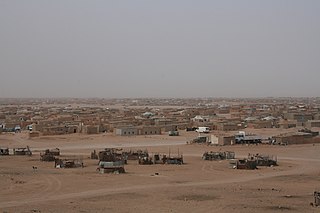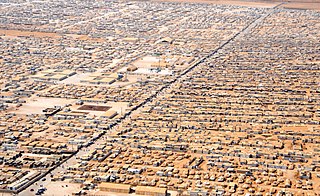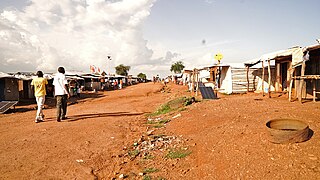Related Research Articles
The Office of the United Nations High Commissioner for Refugees (UNHCR) is a United Nations agency mandated to aid and protect refugees, forcibly displaced communities, and stateless people, and to assist in their voluntary repatriation, local integration or resettlement to a third country. It is headquartered in Geneva, Switzerland, with over 18,879 staff working in 138 countries as of 2020.

A refugee camp is a temporary settlement built to receive refugees and people in refugee-like situations. Refugee camps usually accommodate displaced people who have fled their home country, but camps are also made for internally displaced people. Usually, refugees seek asylum after they have escaped war in their home countries, but some camps also house environmental and economic migrants. Camps with over a hundred thousand people are common, but as of 2012, the average-sized camp housed around 11,400. They are usually built and run by a government, the United Nations, international organizations, or non-governmental organization. Unofficial refugee camps, such as Idomeni in Greece or the Calais jungle in France, are where refugees are largely left without the support of governments or international organizations.
Dolo Addo or Dolo Ado or Dollo Ado is one of the woredas in the Somali Region of Ethiopia. Part of the Liben Zone, Dolo Ado is located in the angle formed by the confluence of the Ganale Dorya with the Dawa River, and bordered to the northwest by Filtu, on the northeast by Afder Zone, on the southeast by Somalia, and on the south by Kenya. Towns in Dollo Ado include Koole, *Helaweyn, and #Buur, Dolo and Suftu. It is home to Garimarro and Degodia who are living in dollo ado.

The Sahrawi refugee camps, also known as the Tindouf camps, are a collection of refugee camps set up in the Tindouf Province, Algeria in 1975–76 for Sahrawi refugees fleeing from Moroccan forces, who advanced through Western Sahara during the Western Sahara War. With most of the original refugees still living in the camps, the situation is among the most protracted in the world.
Goré is a town and the capital of the La Nya Pendé in Chad's Logone Oriental Region.

Garoua-Boulaï is a town and commune in Cameroon. The town is on the border with the Central African Republic. Across the border, the nearest CAR settlement accessible by road is Baboua.
Ngaoui is a town and commune in Cameroon.
Kentzou is a town and commune in Cameroon.
Global Acute Malnutrition (GAM) is a measurement of the nutritional status of a population that is often used in protracted refugee situations. Along with the Crude Mortality Rate, it is one of the basic indicators for assessing the severity of a humanitarian crisis.
Africa Humanitarian Action (AHA) is a non-governmental organization that provides relief services to countries in Africa. It was founded by Dr. David Zawde in 1994 in response to the Rwandan genocide.

The Zaatari refugee camp is a refugee camp in Jordan, located 10 kilometres (6.2 mi) east of Mafraq, which has gradually evolved into a permanent settlement; it is the world's largest camp for Syrian refugees. It was first opened on 28 July 2012 to host Syrians fleeing the violence in the ongoing Syrian War that erupted in March 2011. It is connected to the road network by a short road which leads to Highway 10.
Refugees in Jordan rose with the uprising against the Syrian government and its President Bashar al-Assad. Close to 13,000 Syrians per day began pouring into Jordan to reside in its refugee camps.
As of 31 August 2020, Cameroon hosted a total refugee population of approximately 421,700. Of these, 280,500 were from the Central African Republic, driven by war and insecurity. In the Far North Region, Cameroon hosts 114,300 Nigerian refugees, with the population sharing their already scarce resources with the refugees.
Nigerian refugees are persons originating from the country of Nigeria, but seeking refuge outside the borders of their native country. Nigeria has a refugee crisis which has extended for almost a decade, mainly due to the insurgency in Northern Nigeria by the Boko Haram.
Gbiti is a border town in the East Province in Cameroon.
Mbilé, or Mbilé Refugee Camp, is located near the village of Lolo in Kadey Department, East Region, Cameroon.
South Sudanese refugees are persons originating from the African country of South Sudan, but seeking refuge outside the borders of their native country. The world's youngest independent country has a recent and troubled history of prolonged conflicts and ecosystem mismanagement such as overlogging, which has led to desertification. These forces have resulted not only in violence and famine, but also the forced migration of large numbers of the population, both inside and outside the country's borders. South Sudan was cited as the largest refugee crisis in 2016, being the world's third largest, followed by Syria and Afghanistan. As of 2022, the UNHCR estimated that there were 2.4 million refugees under its mandate originating from South Sudan, making the country the fifth largest source of refugees.

Nakivale refugee settlement is a settlement located in Isingiro District near the Tanzania border in Southwest Uganda.

Bidibidi Refugee Settlement is a refugee camp located in Yumbe District's West Nile sub-Region in Uganda. It is one of the world’s largest refugee settlements, housing approximately 285,000 refugees fleeing conflict in South Sudan as of late 2016. In 2017, and refugees from DR congo. it was described as the largest refugee settlement site in the world, and in 2023, it was labeled "Africa’s largest refugee camp" by The Guardian.
Cishemeye Transit Center was a temporary refugee camp in Burundi created by United Nations High Commissioner on Refugees to house refugees who were fleeing from the Kivu in Democratic Republic of Congo.
References
- 1 2 3 "CAR refugees stretch Cameroon villages". IRIN Africa. 2014-06-03. Retrieved 2014-06-08.
- ↑ "Lolo - Map - Cameroon". Google Satellite Maps. Retrieved 2014-06-08.
- ↑ "CAR refugees face acute challenges in Cameroon". Plan UK. 2014-03-25. Retrieved 2014-06-08.
- ↑ UNHCR - Office of the United Nations High Commissioner for Refugees (2014-02-22). "Cameroon: some 20,000 more CAR refugees in three weeks". NationalJournal.com. Retrieved 2014-06-08.
- ↑ "C.A.R. Regional Impact Situation Report #2, 3 June 2014 - Cameroon". ReliefWeb. 2014-06-03. Retrieved 2014-06-08.
- ↑ Traveling Luck for Lolo I, Cameroon (general), Cameroon